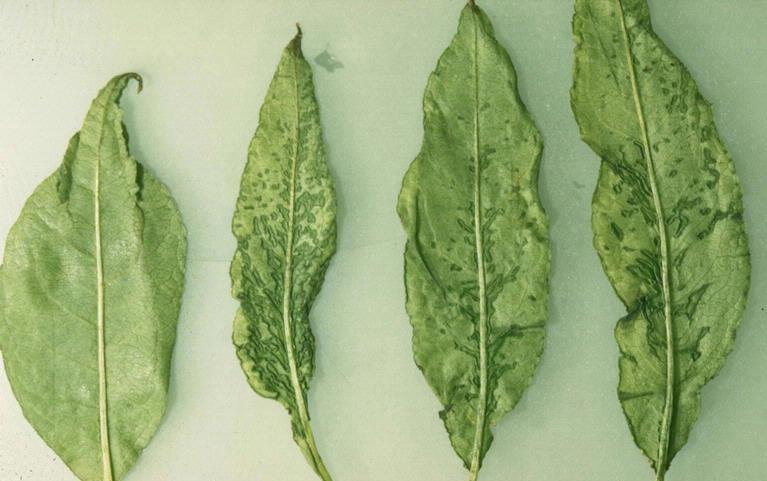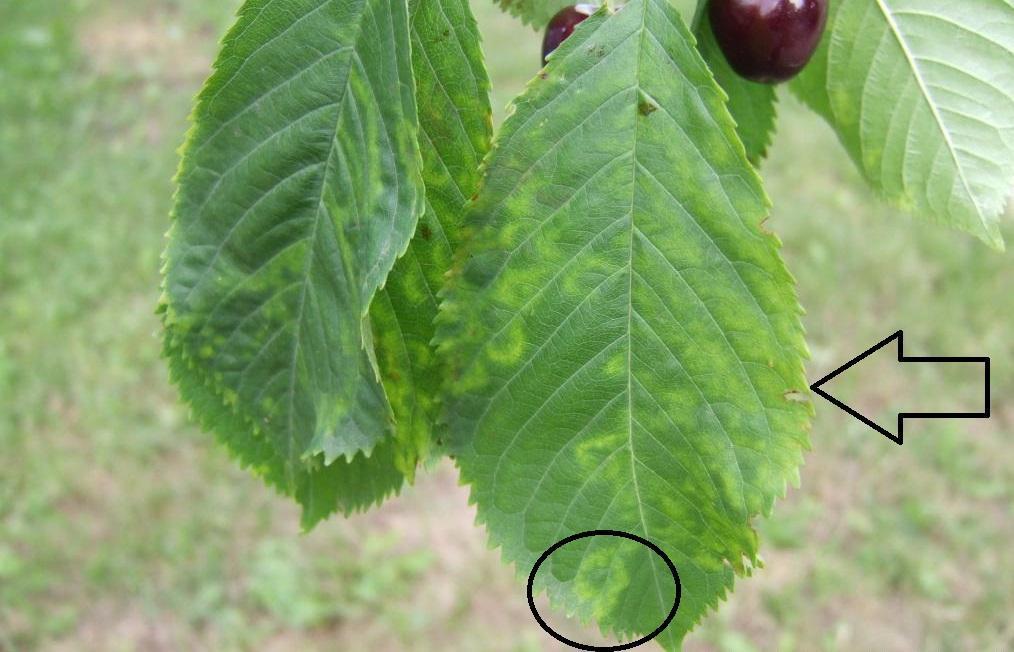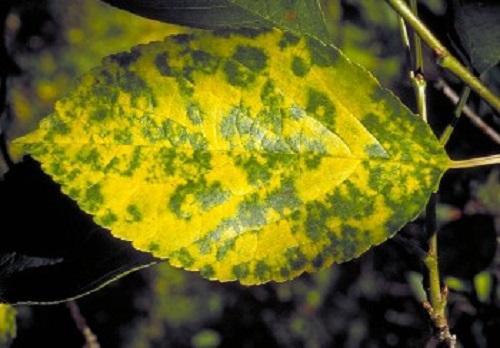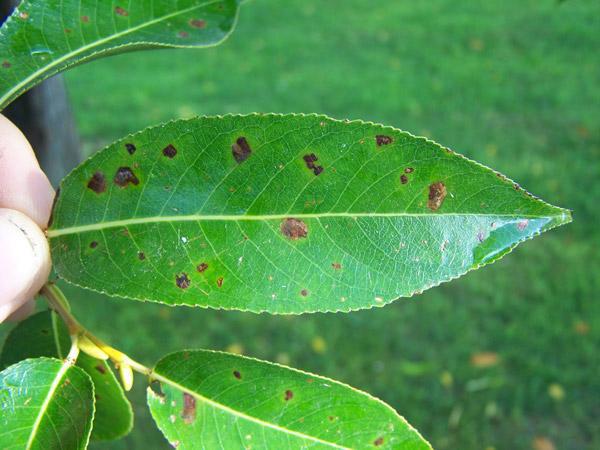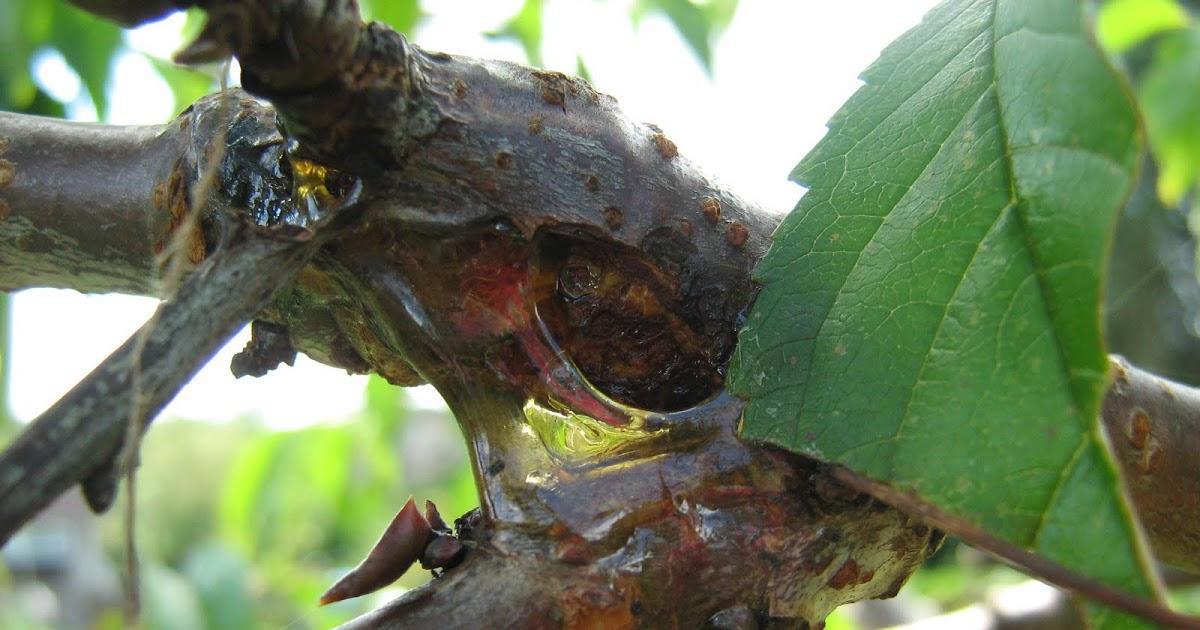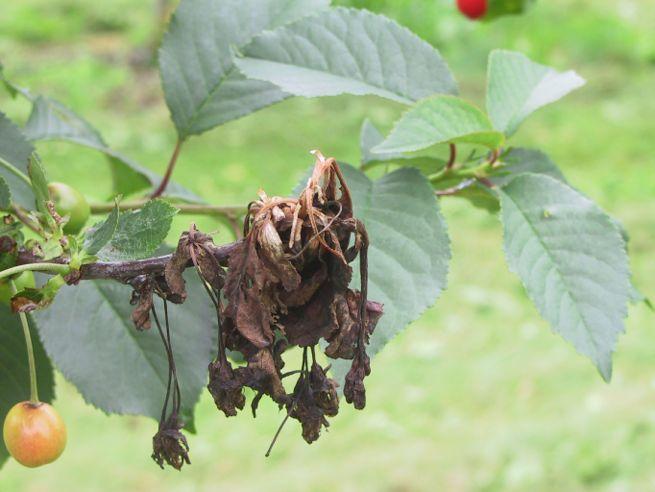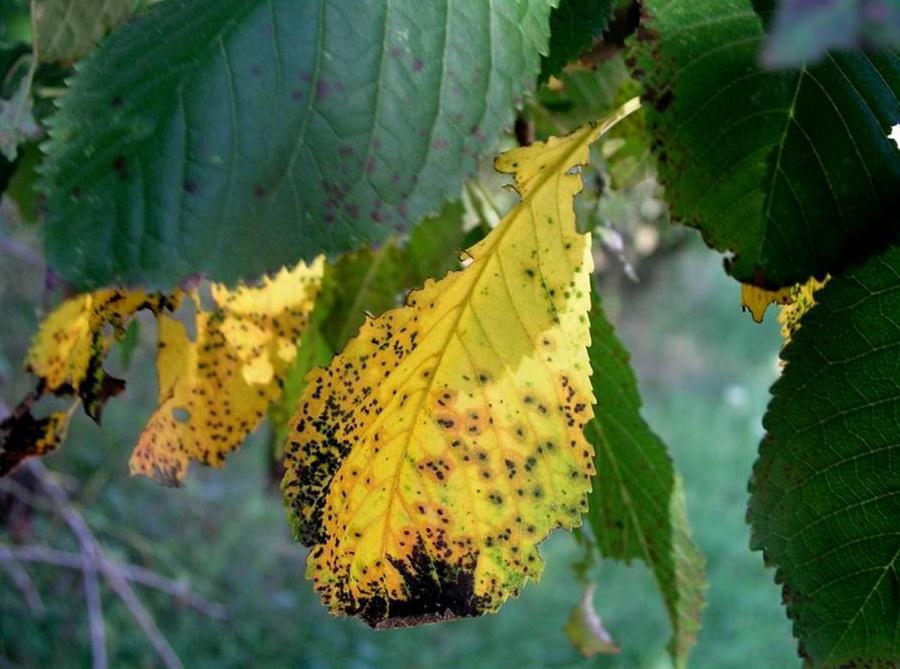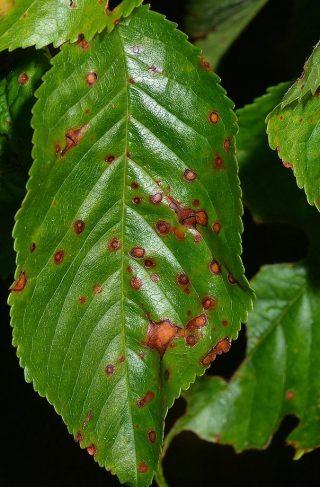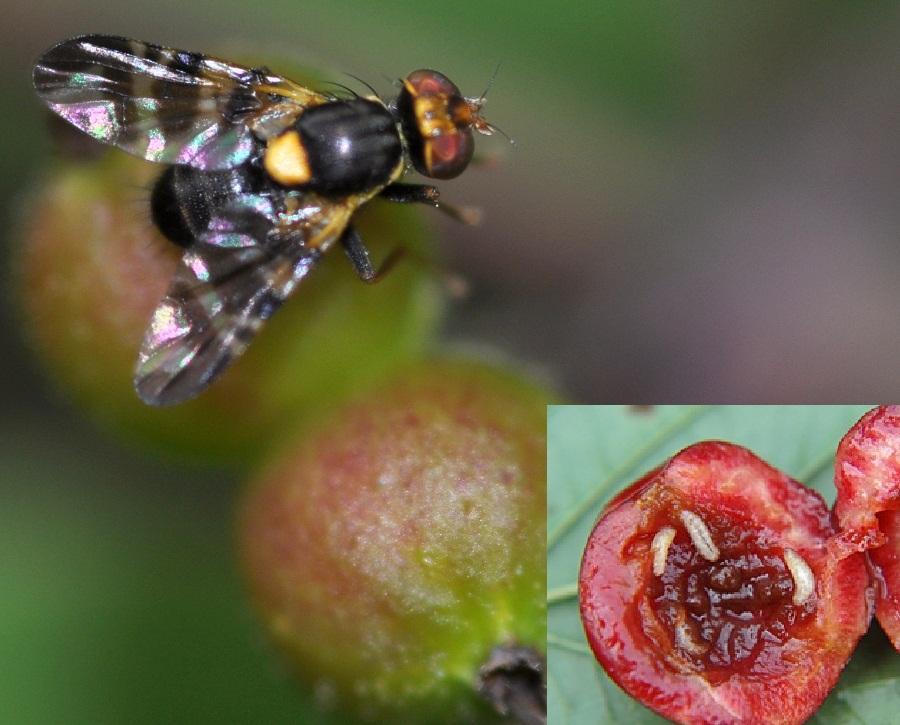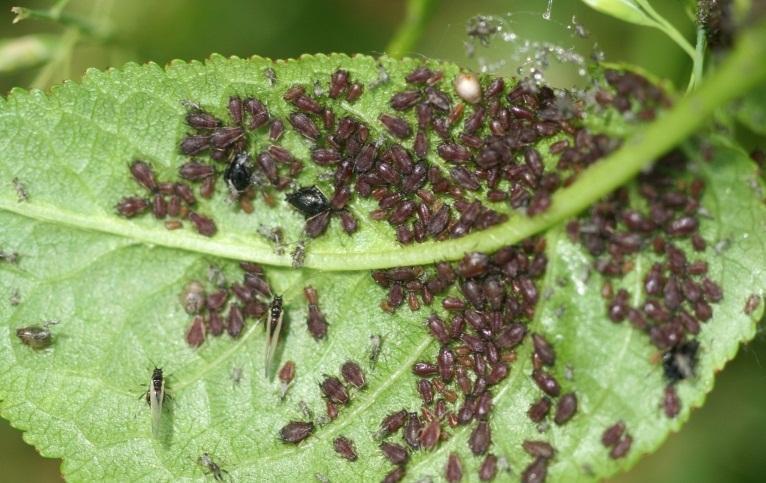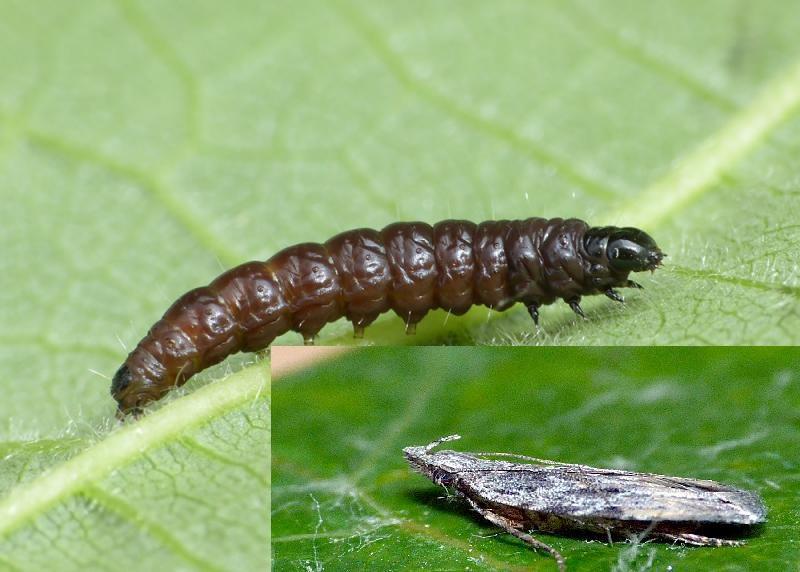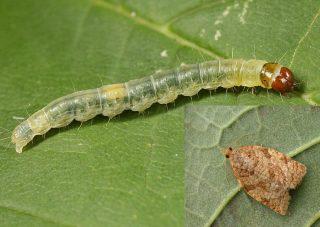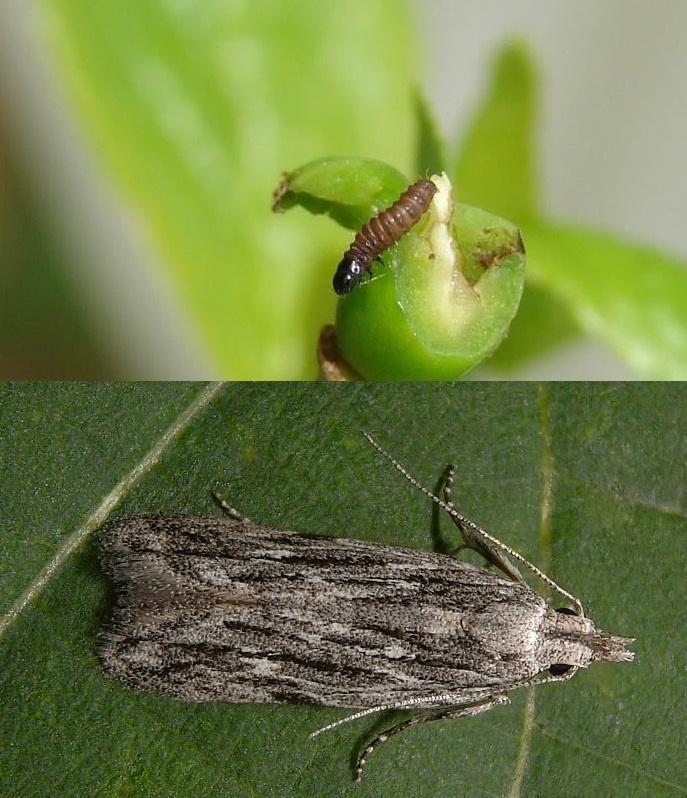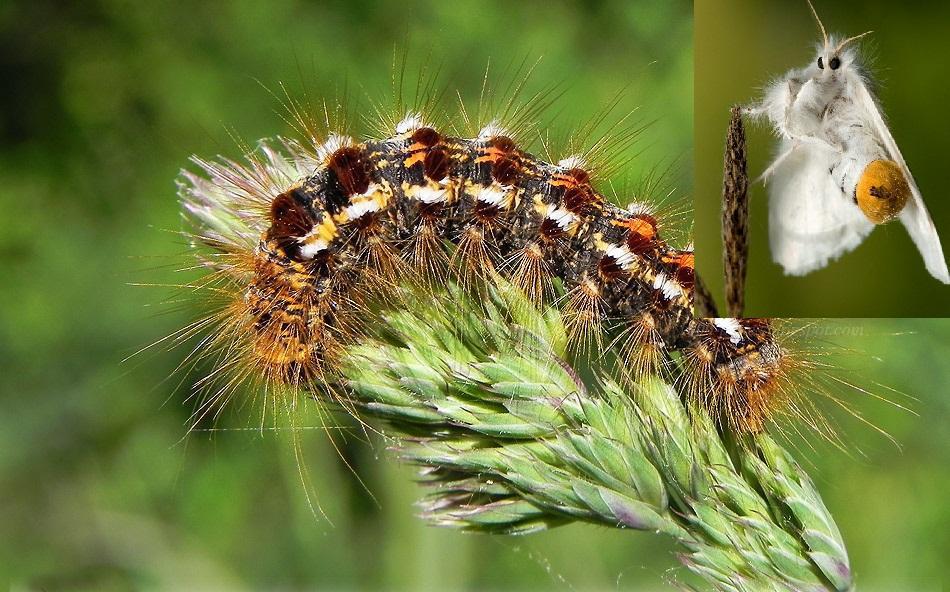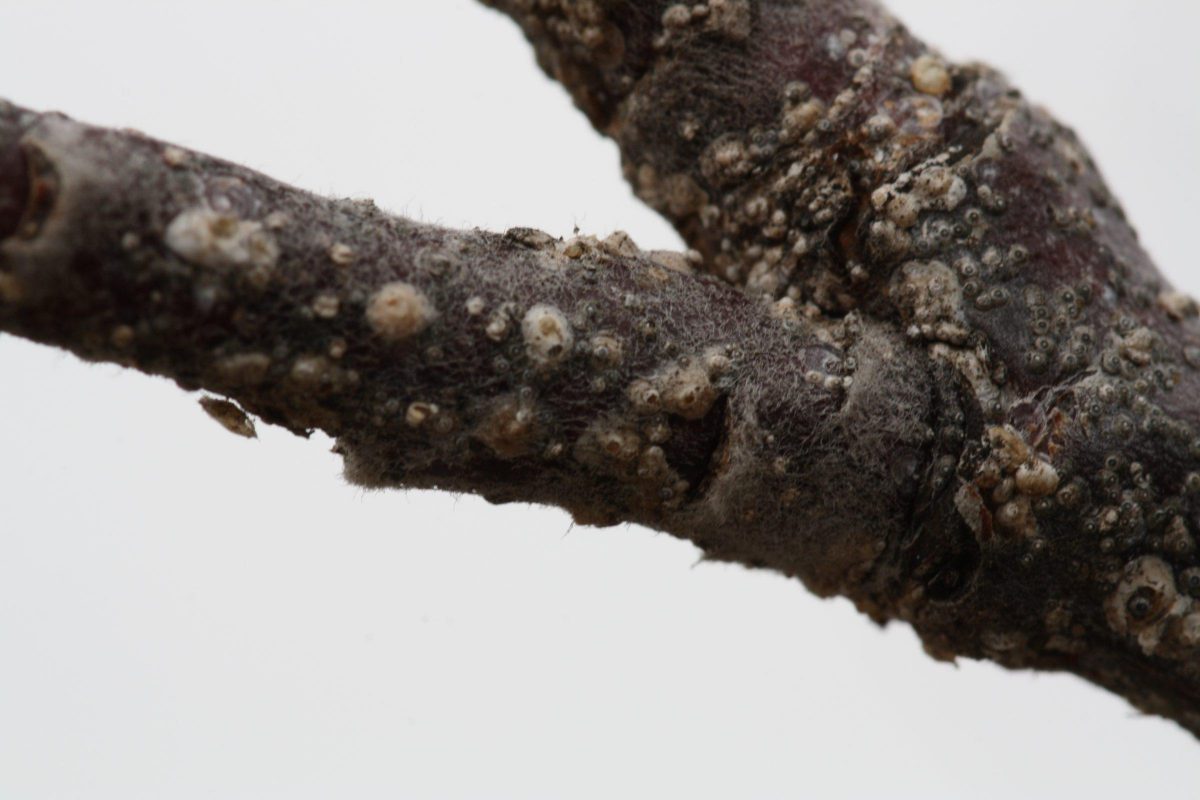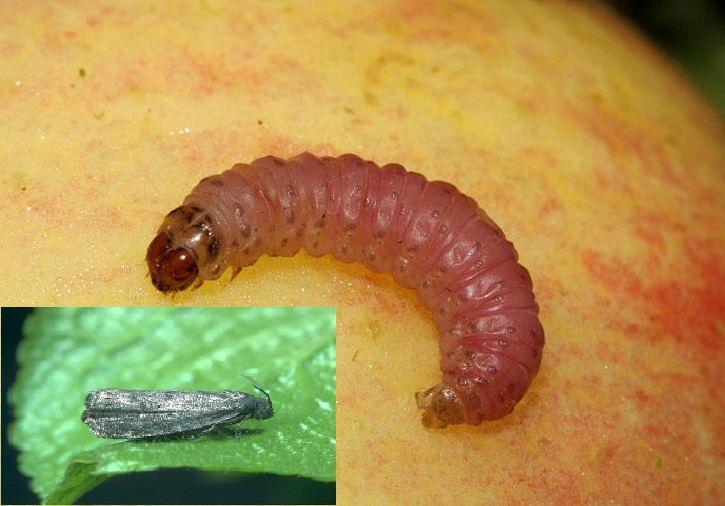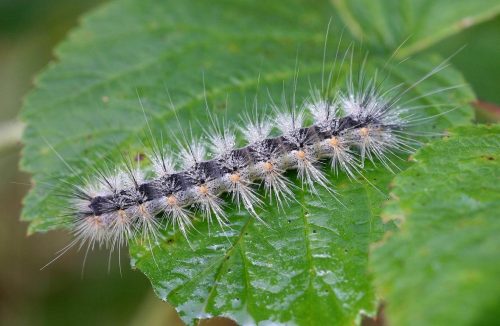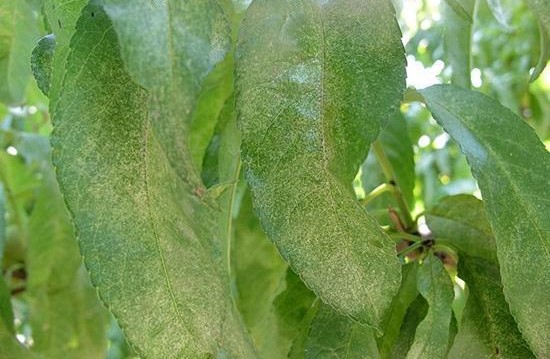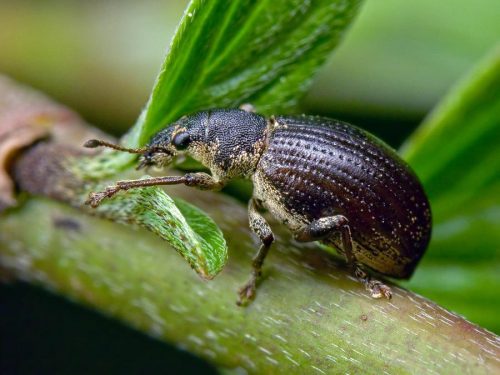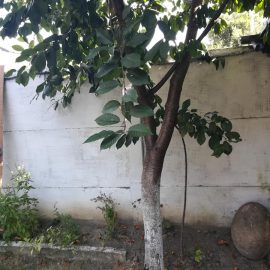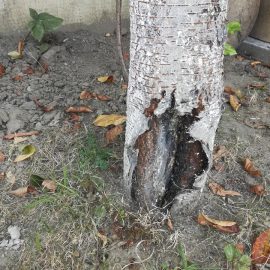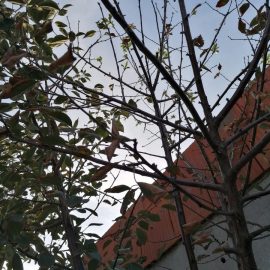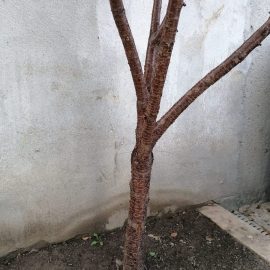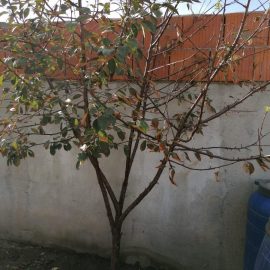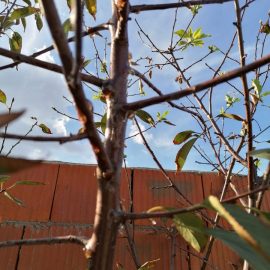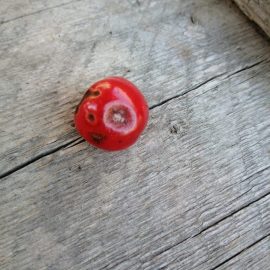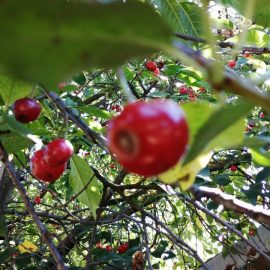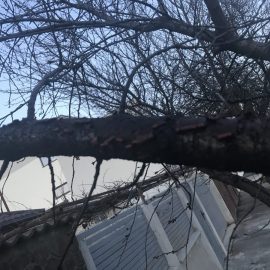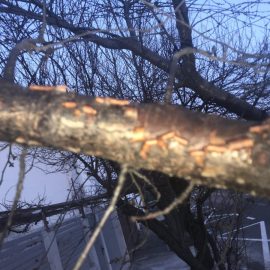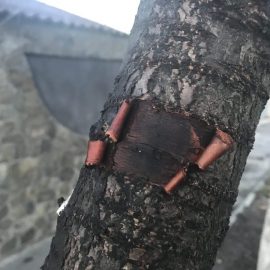Sour cherry treatments, pest and disease control
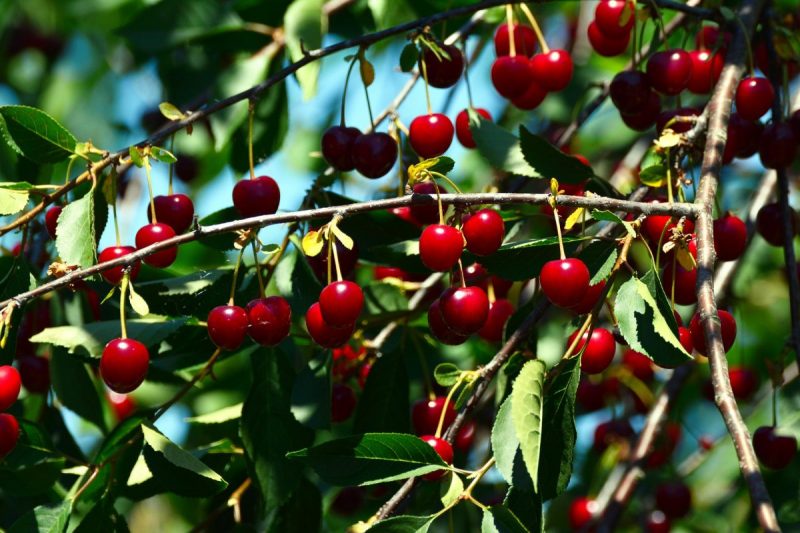
Sour cherry (Prunus cerasus) is a fruit tree related to the cherry tree and belongs to the Rosaceae family. It develops a low-vigor crown, and its growth rate is slower than that of the cherry tree. The sour cherry is thought to be native to Iran. The sour cherry leaves are glossy and toothed on the edge, and the flowers are white. Fruits have a beneficial effect on the human body by regulating the acid-base balance, improving blood composition, and relieving liver, kidney, and cardiovascular diseases. Fruits contain sugars, organic acids, proteins, pectins, potassium, phosphorus, calcium, magnesium, vitamins, and carotene.
The main diseases of sour cherry trees
VIRUSES
Cherry leaf roll virus
This virus is present in aged orchards. The symptoms are very varied. Ring spots, redness, or twists may appear on the leaves. Affected tree twigs will stop growing. In case of a strong attack, the leaves become twisted. The virus is transmitted by grafting, seed, and pollen.
Prevention and control measures:
- checking the saplings before planting;
- using healthy grafts and rootstocks.
Prunus necrotic ringspot virus
Circular, ring-shaped, discolored spots appear on the tree leaves. Attacked tissues fall off, and the leaf appears perforated. Attacked trees no longer develop normally. Symptoms often appear in spring. This virus attacks all species of stone fruit trees and is transmitted by pollen, mites, and nematodes.
Prevention and control measures:
- planting healthy saplings;
- removing attacked trees from the orchard;
- insecticide treatments to control the insect population.
Sour cherry yellows virus
Discoloration spots appear on the leaves at the base of the tree. Thus, the leaves acquire a mosaic appearance. In a short time, they turn yellow and fall. After the attack, the sour cherry tree produces fewer fruits. The virus is transmitted by grafting and pollen.
Prevention and control measures:
- using healthy grafts and rootstocks;
- planting healthy saplings.
BACTERIOSIS
Bacterial canker of stone fruits (Pseudomonas syringae pv. morsprunorum)
Small, circular, watery-looking spots appear on the leaves. When humidity is high, bacterial ooze appears on the spot’s surface as a yellowish-white, viscous pellicle. In hot weather, the attacked tissues dry out and fall off the leaf. A strong attack causes defoliation. Small, pinkish-brown spots appear on the fruits. The attack causes fruit deformation and pulp cracking. As a result, sour cherry trees lose their commercial value. Long spots appear on the twigs, and the bark turns brown and gets damaged. The wounds produce a viscous fluid, specific to bacteriosis. The wounds increase in size from one year to the next and can develop into open cancers. Bacteria enter the tree through stomata, but most infections occur during grafting.
Prevention and control measures:
- using healthy grafts and rootstocks;
- chemical treatments with copper-based fungicides.
Recommended products
-
You can find products on a different store
Change Store -
You can find products on a different store
Change Store -
You can find products on a different store
Change Store -
You can find products on a different store
Change Store -
You can find products on a different store
Change Store -
You can find products on a different store
Change Store -
You can find products on a different store
Change Store -
You can find products on a different store
Change Store -
You can find products on a different store
Change Store -
You can find products on a different store
Change Store -
You can find products on a different store
Change Store -
You can find products on a different store
Change Store -
You can find products on a different store
Change Store -
You can find products on a different store
Change Store -
You can find products on a different store
Change Store -
You can find products on a different store
Change Store -
You can find products on a different store
Change Store -
You can find products on a different store
Change Store -
You can find products on a different store
Change Store -
You can find products on a different store
Change Store -
You can find products on a different store
Change Store -
You can find products on a different store
Change Store -
You can find products on a different store
Change Store -
You can find products on a different store
Change Store
Crown gall (Agrobacterium radiobacter pv. tumefaciens)
Symptoms occur as tumors (galls), which vary in size depending on the plant’s age and the affected organ. Initially, small, smooth, and soft tumors appear on roots, stems, and rarely on branches or leaves. With time, the tumors enlarge, become brown or blackish-brown, and have a rough appearance. The pathogen enters the sour cherry tree through wounds caused by nematodes, hail, insects, etc. The disease is also favored by temperatures between 22 and 30 °C and atmospheric humidity of 80 %.
Prevention and control measures:
- sorting saplings before planting;
- sour cherry saplings should be planted on land that has been prepared accordingly;
- disinfecting scissors and tools when moving from one tree to another;
- pruning affected branches up to the healthy area, applying treatment with Bordeaux mixture, and covering wounds with tree wound sealer;
- soaking the sapling roots in a solution of Bordeaux mixture of 1%;
- treatments during vegetation with copper-based products.
Recommended products
-
You can find products on a different store
Change Store -
You can find products on a different store
Change Store -
You can find products on a different store
Change Store -
You can find products on a different store
Change Store -
You can find products on a different store
Change Store -
You can find products on a different store
Change Store -
You can find products on a different store
Change Store -
You can find products on a different store
Change Store -
You can find products on a different store
Change Store -
You can find products on a different store
Change Store -
You can find products on a different store
Change Store -
You can find products on a different store
Change Store -
You can find products on a different store
Change Store -
You can find products on a different store
Change Store -
You can find products on a different store
Change Store -
You can find products on a different store
Change Store -
You can find products on a different store
Change Store -
You can find products on a different store
Change Store -
You can find products on a different store
Change Store -
You can find products on a different store
Change Store -
You can find products on a different store
Change Store -
You can find products on a different store
Change Store -
You can find products on a different store
Change Store -
You can find products on a different store
Change Store
MYCOSIS
Brown rot (Monilinia laxa)
This disease attacks all the aerial organs of the trees, causing significant damage in the cold and rainy years. The attacked leaves hang without falling, the flowers turn brown and dry, and the branches bend into a hook shape. The young fruits shrivel up, turn brown, and fall massively. The pulp of mature fruit rots and yellowish-grey spots appear on the outside. Eventually, the fruits mummify and remain on the tree, ensuring disease transmission into the following year. The fungus overwinters on the mummified fruit and in the bark of attacked branches.
Prevention and control measures:
- gathering and destroying attacked fruits;
- cutting and burning of the affected branches;
- cutting the affected branches down to the healthy area, applying treatment with Bordeaux mixture, and covering the wounds with tree wound sealer;
- chemical treatments during the dormant period with copper-based products;
- preventive treatments applied in vegetation with specific fungicides.
Recommended products
-
You can find products on a different store
Change Store -
You can find products on a different store
Change Store -
You can find products on a different store
Change Store -
You can find products on a different store
Change Store -
You can find products on a different store
Change Store -
You can find products on a different store
Change Store -
You can find products on a different store
Change Store -
You can find products on a different store
Change Store -
You can find products on a different store
Change Store -
You can find products on a different store
Change Store -
You can find products on a different store
Change Store -
You can find products on a different store
Change Store -
You can find products on a different store
Change Store -
You can find products on a different store
Change Store -
You can find products on a different store
Change Store -
You can find products on a different store
Change Store -
You can find products on a different store
Change Store -
You can find products on a different store
Change Store -
You can find products on a different store
Change Store -
You can find products on a different store
Change Store -
You can find products on a different store
Change Store -
You can find products on a different store
Change Store -
You can find products on a different store
Change Store -
You can find products on a different store
Change Store
Cherry leaf spot (Blumeriella jaapii)
Small spots with a diameter of 2-3 mm appear on the top side of the leaves. These spots have a circular shape and a red-purple color. The attack covers the entire leaf, which turns yellow with purple spots, and on the underside, the spots get covered with a whitish mold. The attacked leaves detach from the branches. This causes premature defoliation with negative effects on production. Tree vigor and frost resistance are also reduced.
Prevention and control measures:
- burning twigs and attacked fruits;
- chemical treatments with specific fungicides.
Recommended products
-
You can find products on a different store
Change Store -
You can find products on a different store
Change Store -
You can find products on a different store
Change Store -
You can find products on a different store
Change Store -
You can find products on a different store
Change Store -
You can find products on a different store
Change Store -
You can find products on a different store
Change Store -
You can find products on a different store
Change Store -
You can find products on a different store
Change Store -
You can find products on a different store
Change Store -
You can find products on a different store
Change Store -
You can find products on a different store
Change Store -
You can find products on a different store
Change Store -
You can find products on a different store
Change Store -
You can find products on a different store
Change Store -
You can find products on a different store
Change Store -
You can find products on a different store
Change Store -
You can find products on a different store
Change Store -
You can find products on a different store
Change Store -
You can find products on a different store
Change Store -
You can find products on a different store
Change Store -
You can find products on a different store
Change Store -
You can find products on a different store
Change Store -
You can find products on a different store
Change Store
Shot-hole disease (Stigmina carpophila)
The disease is common in neglected orchards and causes significant damage to stone trees. Circular spots appear on the leaves near which the tissues turn brown and finally detach from the rest of the leaf. On the fruit appear punctiform formations, surrounded by a reddish-purple border. The fruit pulp loses its texture and taste. Brown spots appear on the twigs, followed by wounds from which gummosis leaks. This form of attack is very dangerous because it dries the twigs that bear fruit buds. The spores spread the fungus and resist over winter in the ooze that leaks from the wounds. The fungus can overwinter as mycelium on the branches’s surface.
Prevention and control measures:
- pruning and burning the affected branches;
- covering wounds resulting from pruning with tree wound sealer;
- applying a treatment with Bordeaux mixture after pruning;
- preventive treatments applied in vegetation with specific fungicides.
Recommended products
-
You can find products on a different store
Change Store -
You can find products on a different store
Change Store -
You can find products on a different store
Change Store -
You can find products on a different store
Change Store -
You can find products on a different store
Change Store -
You can find products on a different store
Change Store -
You can find products on a different store
Change Store -
You can find products on a different store
Change Store -
You can find products on a different store
Change Store -
You can find products on a different store
Change Store -
You can find products on a different store
Change Store -
You can find products on a different store
Change Store -
You can find products on a different store
Change Store -
You can find products on a different store
Change Store -
You can find products on a different store
Change Store -
You can find products on a different store
Change Store -
You can find products on a different store
Change Store -
You can find products on a different store
Change Store -
You can find products on a different store
Change Store -
You can find products on a different store
Change Store -
You can find products on a different store
Change Store -
You can find products on a different store
Change Store -
You can find products on a different store
Change Store -
You can find products on a different store
Change Store
The main pests of sour cherry tree
European cherry fruit fly (Rhagoletis cerasi)
It is a particularly dangerous species, it can cause damage even after harvest. The attacked fruits acquire a light color and rot. It develops one generation per year and overwinters as a pupa in the surface layer of the soil. Adults appear in the second decade of May and fly for about 30 days.
Control methods:
- chemical treatments at adult emergence with specific insecticides.
Black Cherry Aphid (Myzus cerasi)
It is a dangerous species that aggressively attacks the sour cherry tree, affecting its growth and fruiting. It has several generations per year and overwinters like an egg. The attack begins in spring when the adults colonize the leaves and growing tips. Aphids feed on leaves sap producing small growths and transmitting various diseases (usually viruses).
Control methods:
- chemical treatments with specific insecticides.
The peach twig borer (Anarsia lineatella)
This species is also found in sour cherry trees. It develops three generations per year and overwinters as a larva under the exfoliated bark. In the spring, they leave the winter shelter and attack the buds. In young twigs, the larvae gnaw penetrating holes. Newly emerged females lay eggs on the buds, and the larvae will penetrate the fruits of the early varieties. The larvae of the next generations penetrate the fruits in the ripening phase, where they dig deep galleries.
Control methods:
- pruning and destroying the affected branches (twigs);
- chemical treatments with specific insecticides.
Recommended products
-
You can find products on a different store
Change Store -
You can find products on a different store
Change Store -
You can find products on a different store
Change Store -
You can find products on a different store
Change Store -
You can find products on a different store
Change Store -
You can find products on a different store
Change Store -
You can find products on a different store
Change Store -
You can find products on a different store
Change Store -
You can find products on a different store
Change Store -
You can find products on a different store
Change Store -
You can find products on a different store
Change Store -
You can find products on a different store
Change Store -
You can find products on a different store
Change Store -
You can find products on a different store
Change Store -
You can find products on a different store
Change Store -
You can find products on a different store
Change Store -
You can find products on a different store
Change Store -
You can find products on a different store
Change Store -
You can find products on a different store
Change Store -
You can find products on a different store
Change Store -
You can find products on a different store
Change Store -
You can find products on a different store
Change Store -
You can find products on a different store
Change Store -
You can find products on a different store
Change Store
Summer fruit tortrix (Adoxophyes orana)
It is a polyphagous species that attacks over 47 species of herbaceous and woody plants (including the sour cherry tree). In spring, the larvae gnaw on buds, flowers, and leaves. The larvae enter the fruit where they dig shallow galleries. The wounds made are the entry points for fungi of the genus Monilinia.
Control methods:
- chemical treatments with specific insecticides.
Recommended products
-
You can find products on a different store
Change Store -
You can find products on a different store
Change Store -
You can find products on a different store
Change Store -
You can find products on a different store
Change Store -
You can find products on a different store
Change Store -
You can find products on a different store
Change Store -
You can find products on a different store
Change Store -
You can find products on a different store
Change Store -
You can find products on a different store
Change Store -
You can find products on a different store
Change Store -
You can find products on a different store
Change Store -
You can find products on a different store
Change Store -
You can find products on a different store
Change Store -
You can find products on a different store
Change Store -
You can find products on a different store
Change Store -
You can find products on a different store
Change Store -
You can find products on a different store
Change Store -
You can find products on a different store
Change Store -
You can find products on a different store
Change Store -
You can find products on a different store
Change Store -
You can find products on a different store
Change Store -
You can find products on a different store
Change Store -
You can find products on a different store
Change Store -
You can find products on a different store
Change Store
Oriental fruit moth (Grapholita molesta)
It has 3-4 generations per year and overwinters like a larva in a silky cocoon in the cracks of the bark. This moth attacks the twigs, leaves, and fruits of the sour cherry tree, but it does the most damage to the fruit. The larvae of the first generations attack the twigs and feed on them, causing great damage to newly established orchards and nurseries. The larvae of generations III and IV cause significant damage to the fruit. They enter the fruit through the stalk area or the “tip” area and gnaw irregular galleries around the pit. Fruits stagnate from growth, rot, and fall.
Control methods:
- pruning and destroying attacked fruits and twigs;
- using attractant traps;
- chemical treatments applied during mass flight with specific insecticides.
Recommended products
-
You can find products on a different store
Change Store -
You can find products on a different store
Change Store -
You can find products on a different store
Change Store -
You can find products on a different store
Change Store -
You can find products on a different store
Change Store -
You can find products on a different store
Change Store -
You can find products on a different store
Change Store -
You can find products on a different store
Change Store -
You can find products on a different store
Change Store -
You can find products on a different store
Change Store -
You can find products on a different store
Change Store -
You can find products on a different store
Change Store -
You can find products on a different store
Change Store -
You can find products on a different store
Change Store -
You can find products on a different store
Change Store -
You can find products on a different store
Change Store -
You can find products on a different store
Change Store -
You can find products on a different store
Change Store -
You can find products on a different store
Change Store -
You can find products on a different store
Change Store -
You can find products on a different store
Change Store -
You can find products on a different store
Change Store -
You can find products on a different store
Change Store -
You can find products on a different store
Change Store
Brown-tail moth (Euproctis chrysorrhoea)
It is a polyphagous species that attacks several trees and fruit trees. It has one generation per year and overwinters like a larva in a cocoon at the top of the twigs. The larvae attack buds and leaves and may cause tree defoliation. To detect the presence of this pest, trees should be examined very carefully.
Control methods:
- removing branches on which the larvae are present;
- chemical treatments with specific insecticides.
Recommended products
-
You can find products on a different store
Change Store -
You can find products on a different store
Change Store -
You can find products on a different store
Change Store -
You can find products on a different store
Change Store -
You can find products on a different store
Change Store -
You can find products on a different store
Change Store -
You can find products on a different store
Change Store -
You can find products on a different store
Change Store -
You can find products on a different store
Change Store -
You can find products on a different store
Change Store -
You can find products on a different store
Change Store -
You can find products on a different store
Change Store -
You can find products on a different store
Change Store -
You can find products on a different store
Change Store -
You can find products on a different store
Change Store -
You can find products on a different store
Change Store -
You can find products on a different store
Change Store -
You can find products on a different store
Change Store -
You can find products on a different store
Change Store -
You can find products on a different store
Change Store -
You can find products on a different store
Change Store -
You can find products on a different store
Change Store -
You can find products on a different store
Change Store -
You can find products on a different store
Change Store
San Jose scale (Quadraspidiotus perniciosus)
It is a polyphagous species that attacks over 200 species of plants. It has 1-3 generations per year and overwinters as larvae on the bark of affected species. Females and larvae spread to all organs of the affected plants, including the fruit, and feed on host plants sap. In case of a massive attack, the shields that protect the body of the insect overlap and suffocate the trees. They stagnate from growth, and after 2-3 years they dry out.
Control methods:
- cleaning the branches with a rough brush;
- applying dormant period treatments with horticultural oil-based products;
- chemical treatments with specific insecticides.
Recommended products
-
You can find products on a different store
Change Store -
You can find products on a different store
Change Store -
You can find products on a different store
Change Store -
You can find products on a different store
Change Store -
You can find products on a different store
Change Store -
You can find products on a different store
Change Store -
You can find products on a different store
Change Store -
You can find products on a different store
Change Store -
You can find products on a different store
Change Store -
You can find products on a different store
Change Store -
You can find products on a different store
Change Store -
You can find products on a different store
Change Store -
You can find products on a different store
Change Store -
You can find products on a different store
Change Store -
You can find products on a different store
Change Store -
You can find products on a different store
Change Store -
You can find products on a different store
Change Store -
You can find products on a different store
Change Store -
You can find products on a different store
Change Store -
You can find products on a different store
Change Store -
You can find products on a different store
Change Store -
You can find products on a different store
Change Store -
You can find products on a different store
Change Store -
You can find products on a different store
Change Store
Plum fruit moth (Cydia funebrana)
This species attacks the stone fruit trees. It develops two generations a year and overwinters in a cocoon under the bark of trees or in various sheltered places. The larvae penetrate the fruit and feed on the pulp and seeds. The attacked fruits stagnate from growth and fall. The larvae continue to feed on the fallen fruit. After feeding, they come out of the fruit and look for the right place for winter.
Control methods:
- chemical treatments with specific insecticides.
Fall webworm moth (Hyphantria cunea)
It is a polyphagous species that attacks ornamental trees (mulberry, plane tree, etc.) as well as fruit tree species. It has two generations per year and overwinters as a pupa in the surface layer of the soil. This pest causes tree defoliation and thus lower fruit production. The caterpillars settle on the underside of the leaves and begin to consume them. They also build a kind of nest, inside which they feed.
Control methods:
- chemical treatments with specific insecticides.
Recommended products
-
You can find products on a different store
Change Store -
You can find products on a different store
Change Store -
You can find products on a different store
Change Store -
You can find products on a different store
Change Store -
You can find products on a different store
Change Store -
You can find products on a different store
Change Store -
You can find products on a different store
Change Store -
You can find products on a different store
Change Store -
You can find products on a different store
Change Store -
You can find products on a different store
Change Store -
You can find products on a different store
Change Store -
You can find products on a different store
Change Store -
You can find products on a different store
Change Store -
You can find products on a different store
Change Store -
You can find products on a different store
Change Store -
You can find products on a different store
Change Store -
You can find products on a different store
Change Store -
You can find products on a different store
Change Store -
You can find products on a different store
Change Store -
You can find products on a different store
Change Store -
You can find products on a different store
Change Store -
You can find products on a different store
Change Store -
You can find products on a different store
Change Store -
You can find products on a different store
Change Store
Mites
These pests are very difficult to see with the naked eye. Mites are polyphagous species, attacking many plants and fruit trees, both cultivated and wild species. They feed on plants’ sap. After the attack, the leaves look parchment-like, the flowers abort and the tree stagnates in growth.
Control methods:
- chemical treatments with specific insecticides.
Recommended products
-
You can find products on a different store
Change Store -
You can find products on a different store
Change Store -
You can find products on a different store
Change Store -
You can find products on a different store
Change Store -
You can find products on a different store
Change Store -
You can find products on a different store
Change Store -
You can find products on a different store
Change Store -
You can find products on a different store
Change Store -
You can find products on a different store
Change Store -
You can find products on a different store
Change Store -
You can find products on a different store
Change Store -
You can find products on a different store
Change Store -
You can find products on a different store
Change Store -
You can find products on a different store
Change Store -
You can find products on a different store
Change Store -
You can find products on a different store
Change Store -
You can find products on a different store
Change Store -
You can find products on a different store
Change Store -
You can find products on a different store
Change Store -
You can find products on a different store
Change Store -
You can find products on a different store
Change Store -
You can find products on a different store
Change Store -
You can find products on a different store
Change Store -
You can find products on a different store
Change Store
Sciaphobus squalidus
This pest mainly attacks buds and flower buds. It develops one generation every two years and overwinters as an adult in the topsoil. In spring the adults emerge, climb the trees, and feed on the buds and flower buds. The larvae are not harmful to trees, they feed on the roots of spontaneous herbaceous plants.
Control methods:
- mobilizing the soil in the orchard in autumn;
- chemical treatments with specific insecticides.














































































































































































































































































































































































































































